#lords of cinder
Text
The Soul Still Burns: Analysis of the Lords of Cinder (DS3)
What follows is a short essay on the Lords of Cinder from Dark Souls 3, exploring their symbolism on spiritual and metatextual levels. After that is a related reading of Slave Knight Gael, the final adversary of the Dark Souls trilogy.
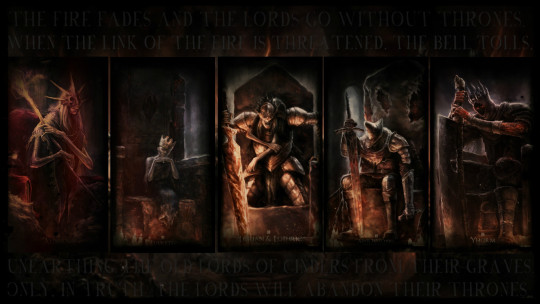
The Lords of Cinder are in many ways the primary adversaries of Dark Souls 3. This title they share, “Lord of Cinder,” refers to a personage who has rekindled the first flame, keeping the cycle of light and dark going.
Cinder is a substance which continues to burn without the presence of fire but does not reduce to ash. So euphemistically, it seems that the Lords are somehow stuck in their process of purification, and the game suggests that the world is stuck along with them; this is why it is the Ashen One’s task to “set them upon their thrones”—to hurry them along and thus allow the world to follow its natural decline. As individual characters, each of these Lords represents a different attitude that complicates and prolongs the cycle.
Through these stubborn Lords the game is commenting on at least two things. On the metaphysical level, it reflects the Buddhist idea that certain attitudes keep people reincarnating over and over again, unable to extricate themselves from the material world of suffering (samsara). While on the metatextual level, the game is suggesting that certain attitudes keep players coming back to Dark Souls again and again, starting new games, making new builds and revisiting old files.
The idea there on the metaphysical side finds an easy analogy in Buddhist doctrine: the “three poisons,” the three root causes of suffering. These are hatred, greed, and delusion. What’s interesting is that these essential vices also fit pretty easily onto the different types of players that are being caricatured by the Lords. We’ll break these correspondences down in a second.
But First: Why Do They Correspond?
So we have these sets of three. Three lords, three poisons in Buddhism, three types of Souls players. How convenient. When we analyze art, we sometimes ask, “Huh, is this structure really there, or am I projecting it into the material?” And if the structure is really there, baked into the work, that doesn’t mean that it’s due to developer intention. Archetypal forms sometimes show up in work via an unconscious influence, be it due to the cultural milieu, personal psychology, or some a priori biological disposition of the human being.
And the thing about Dark Souls is that it’s an unusually honest piece of art, in that its creative team allows their own free associations and intuitions to show up in the work without too much self-censorship or questioning. They make space for a mystery to show up on its own terms, and in leaving its riddles unanswered, there is more space for discovery by the people who play it.
It should also be said that cultural ideas persist for a reason. Beneath the ethics and ideology of the people who originally named the Buddhist “three poisons,” there may be something timeless, something perennially descriptive of human nature. If that is the case, then it would make sense for this same triplicity to unfurl itself in other cultural products. So for one reason or another, these three poisons, these addictions, show up diegetically in the characters and are also expressed in player psychology.
I say all this just because sometimes I feel very aware of the disconnect between much of Souls lore discourse and the broader field of mythological study. Since we are gamers first, there may be this tendency to want to “solve” the lore, but that’s not what we’re doing here. Myth functions because it elaborates our experience of the world through affective resonance; it attaches images and characters and stories which help us anchor our own prelinguistic impressions of the world, cultivating our sensitivity there.
Anyway, let’s look at these Lords.
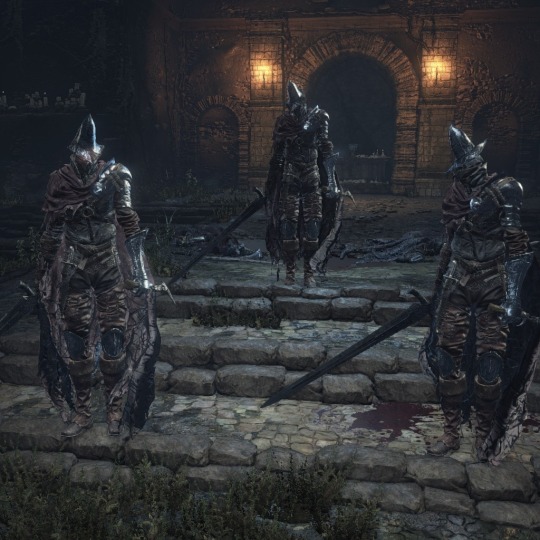
Abyss Watchers
Poison: Hatred
The lore of the Abyss Watchers is pretty clear: they have an obsessive fixation on the abyss, and are ready to raze an entire town if they suspect abyssal encroachment. This obsession has literally possessed them, as they are now “abyss touched.” Gaze too much into the abyss, etc. They carry such strong contempt for the disavowed object that they don’t care what comes between it and their sword. This is clearly demonstrated by the fact that they are a brotherhood yet are unhesitatingly slaughtering themselves again and again. Hatred has made them blind, and has also caused them to resign their individuality (they are identical, mere instruments of a transpersonal grudge). They cannot die, their hatred keeps them locked in combat.
Type of Player: competitive | Interest: combat
The Abyss Watchers are a representation of PvP addicts. They have no powers other than tenacity; they perform the same combos repeatedly. When you are really gripped by a PvP binge in Souls, you often end up doing the same thing again and again. The fight takes place in a mausoleum, on top of many chambers filled with human remains. The fact that this boss fight is instructional about combat, specifically about looking for tells (a cloud of dust always signifies the end of their combos) might be another clue. There is no limit to how good you get at Souls PvP; every foe is an opportunity to improve timing and strategy. You can just keep stacking anonymous bodies under yourself.
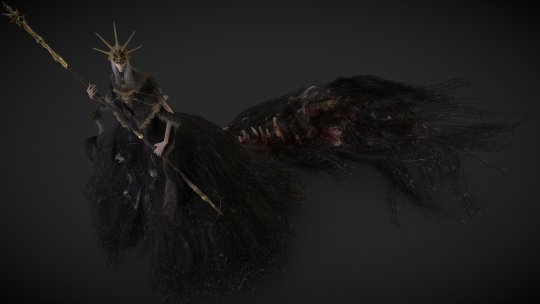
Aldrich
Poison: Greed
Aldrich invokes the concept of supremacy many times: he is in the supreme area from Dark Souls 1; in the supreme boss room of that area; he wears as a crown the former supreme lord of that area. This is because he devours lords; he tries to take prestige upon himself through acquisition and incorporation—greed.
Type of Player: completionist | Interest: content
Aldrich is a commentary on completionist players. He is someone who “plays the game to death”, acquiring every object, reaching every achievement, devouring the soul of the game through taking everything into himself. He becomes bloated by consuming as much of the game’s content as possible. The old God whose likeness he has adopted is Gwyndolin, who was, in narrative terms, the one pulling the strings in the land of the Gods. And in gameplay terms, he is a secret boss. So on both counts we have someone who is elusive, and exists more or less at the boundary of the gameworld. When a player tries to see every last little morsel of a game, they become somewhat like Gwyndolin, a manipulator of a virtual world. If you know too much about a game, you have the risk of being less immmersed.
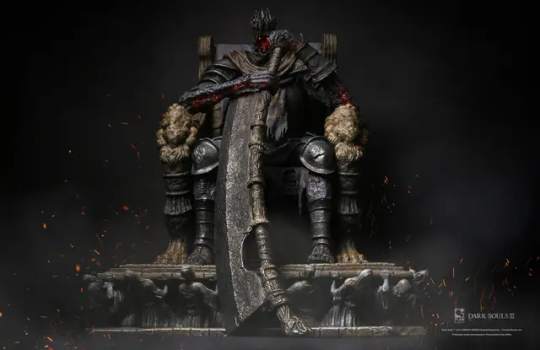
Yhorm
Posion: Delusion
In Buddhism, the poison of delusion secretly underlies the other two poisons, as the impulse toward hatred and greed are ultimately born of some false view about reality. This is akin to how the profaned capital sits below the rest of the kingdoms. To beat Yhorm you essentially have to “play pretend” with him, picking up a fake super-weapon, or fighting alongside Siegward, a knight who appears to be somewhat deluded about the state of the world, enthralled in the same fantasy as Yhorm himself.
Type of Player: lore researcher | Interest: meaning
The profaned capital is full of statues—fixed images of myth; and empty goblets—treasures with no utility. Not to mention the area with the swamp which is full of symbolic imagery, but serves no narrative or mechanical purpose. The entire profaned capital challenges us to make sense of it; it is the ultimate temptation of lorekeepers in DS3. It throws at us a disproportionate amount of reference to DS2, which is famous among Souls players as the least thematically sensible Souls game. The Greatshield of Glory is found right outside Yhorm’s room, in a conspicuous room full of treasure, and yet it is a very impractical shield and offers very little lore value. If a lore-minded player picks it up, it directs them to a legendary personage from the War of Giants, which raises far more questions than it answers. The same is true of much of this area—the Eleanora, the Monstrosities, the Profaned Flame itself—they are all there to get you to speculate. These are the players who come to Souls games again and again, trying to find the “ultimate meaning.” They seek the grail, claim to find it, and then chuck in a pile with the others.
Yhorm's story also imitates the primordial Artorias myth: forsaking his shield in preservation of something more valuable. Other than that Yhorm is largely a cipher when it comes to biography, with a void for a face, which itself epitomizes what must remain at the center of mythology and storytelling: mystery.
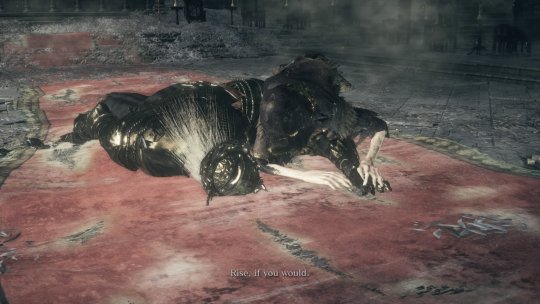
Sit Down and Seek Guidance
So we have the three reasons that people become fixated on Souls: the combat, the achievements, and the mystery. But there is a fourth lord of cinder boss, who is conceptually apart from these three: the Lothric Twins. They represent yet another kind of person who must keep playing Dark Souls: the developers. Lothric is striving to produce “a worthy heir,” a proper sequel to Dark Souls 1. The Princes are bound to their chamber as the developers are bound to their project, as that is their curse—“but you may rest here too, if you like.” In this context we can see their duality as the dual nature of having to work on the game and also play it to death. The privilege and the loftiness of the promise of a great piece of art (Lothric), and also having to go back "into the trenches" of the work itself (Lorian). Notably, neither of them can walk, they just teleport around. They are stuck at work, trying to bring the new world into being. Also I can’t go this whole essay without mentioning the obvious: that the Ashen One is bringing Lords to their thrones, and we players and developers have to assume our little chairs and couches when we access this world.
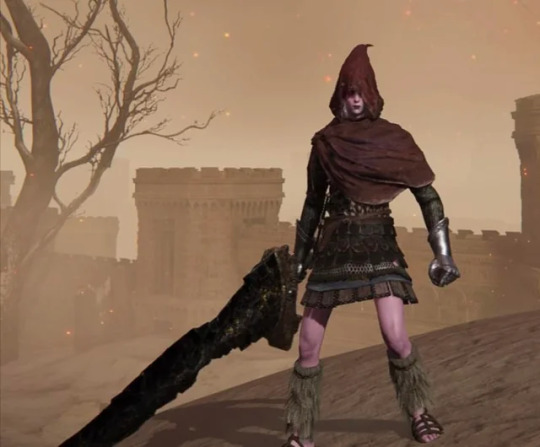
Playing Beyond the Point of Pleasure
Of course the most extreme example of someone stubbornly remaining in the world no matter what is Slave Knight Gael. He is looking for pigment, which seems to be a euphemism for the substance of humanity (the Dark Soul). He wants to give it to the painter, the world-creator, so that a new world can be made. He is willing to indulge in a wasteland of abject violence for as long as it takes in order to renew something. Ironic that he is probably only prolonging the current world in his obsessive drive to recycle it faster.
Let’s examine the relationship between the figure of the painter and her relationship to Gael. That she is a spiritual entity is obvious: we never see her touch the ground, she is always in an upper room and lifted on a piece of furniture. Among other things, she is a clear metaphor for life springing eternally. A creative child who continues to paint despite kidnapping and imprisonment. She is the heart of the painted world, itself a place that symbolizes the idea of the representation of reality.
I want to make sure this is clear, because it is a bit of a kaleidoscope to consider. Any subject in Dark Souls stands for many things, but something that the painted world specifically represents is the very concept of representation. So of course the places in our imaginations are painted worlds, but so is this physical world of appearance, the maya of mundane reality. Not to mention that a work of art is a painted world, and the game we’re discussing is a painted world. When a work of art is able to recreate itself in itself, we can see this funny effect of mirrors reflecting mirrors infinitely. This results in seemingly inexhaustible symbolic content—there is so much potential to find meaning and create connections. Because Moby Dick represents a work of literature; the Tempest represents a play; Twin Peaks represents a TV show, these works can offer extensive insights not only into their medium but into the nature of reality. In these and other examples, the representation of the medium within the work may or may not be a single subject, but since Dark Souls is formally a game about levels and level design, the painted world is the heart of its self-reflexivity. The painted world can be pointed to as the summary of this fractal device. And the personification of that device, its ambassador to the player, is the painter.
The miracle or divine child is also an archetype familiar to us from Lothric, in their struggle to produce the “worthy heir.” Reality seeks salvation through the appearance of grace. They want it in a clear, incontestable form—to be able to point at it and say, "thank goodness we went through all that, because look, now here is the meaning, here is that which validates all that came before." In the world of Dark Souls 3 the religion of the masses is the Lothric stuff; meanwhile knowledge of the painted world is much more obscure. Lothric’s religion is obviously regulated and hierarchical, while Gael’s devotion to the painter is highly personal and private: he carries around a scrap of painting; he prostrates to a hidden idol in a small chapel; he considers the painter his family. He is emotionally close to the object of his worship.
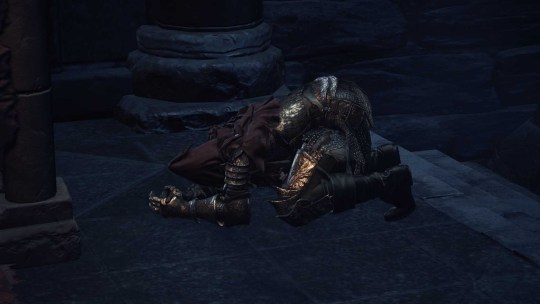
But whether it’s Lothric or Ariandel, they are anticipating the divine child to redeem the world. As an archetype, the child ultimately represents surprise. The possibility of being delighted by life in its creative novelty. The child as an archetype appears in our own behavior when we do something without any sort of contrivance or mental interference, doing something in the world which doesn’t seem to have come from who we conceive ourselves to be. This is miraculous. Such an action enchants the world, and there is no explaining it, even if it may weave all kinds of stories around itself, retroactively framing things that have led up to it as portents or promises. (Though not exclusive to him, this trait is well-known in characterizations of Christ, and DS3 is clearly indebted to Christian iconography, so do with that what you will). Regardless of the specific cultural invocation, the divine child is a personification of something that happens within the human spirit. TFW you are renewed by a fresh and spontaneous engagement with life.
The grace of the miraculous often comes to us through play. Play is more of an attitude than an activity; the feeling of play may come to us through making a painting, or chatting with a friend, or moving around in a video game. We can play video games idly, competitively, experimentally, creatively, studiously, whatever, the feeling of “play” can show up regardless. We can sit there playing a certain game from a certain motivation, and feel totally rote and joyless, and question, “Why am I doing this?” Or we might sit there and play the same game with the same motivation, feeling totally lit up by it, its purpose to us obvious and self-validating. We are not even questioning why we are doing it, we are enjoying life.
This is really the ground that the miraculous tends to land on. Grace, meaning, and an immanent love of life are more likely to show up when we are in flow and not exercising our capacity for self-assessment. But like everything in life, we mistake the images and objects around us for the feeling of grace. Any given object might only be the catalyst once; it’s not about the object. This is extremely easy to see in cases of acute nostalgia; adults chase enchantment through collecting Zelda memorabilia or going to Disneyland, in pursuit of what kindled their spirit as a child. It was never really the game or the character that was doing it, it was what they were able to access within themselves.
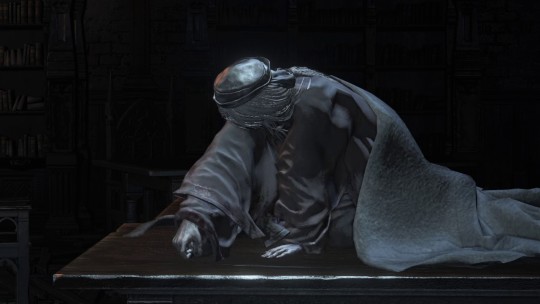
So anyway Gael has yet to realize this. He thinks the Dark Soul is out there in something else. That it will be yielded as a drop if he just kills the right enemy, or 10,000 enemies, or goes to the right place at the right time. You can see that this is something of a synthesis of all the other Buddhist defilements: there are elements of completionism/greed, violence/hatred, mysticism/delusion. There is even the suggestion of the developer of these games again, in that Gael is a “slave,” forced into participation in the world to assist some creative apotheosis. (Isn’t it funny that his weapon is a worn-down executioner’s sword?—whether the person coding or the person playing, we are all “executing” command after command). The thing that really keeps him on the wheel is something beyond any of the player types and their vices; it is almost some sort of pure, amoral automatism, a churning drive that on one side resembles wanton nihilism, and on another side single-minded piousness. Is one disguised as the other, or has Gael somehow stepped beyond this binary? Yet another dichotomy in Dark Souls that begs to be reconciled, but whose tension creates the opportunity to participate creatively in its expansive mythology. When things are held apart we can move between them.
To really understand Gael, we have to contend with the question of a person’s relationship to their own soul, since that relationship is so plainly suggested by Gael and the painter. (This question, by the way, is much elaborated in Elden Ring, with its repeated foregrounding of the image of the maiden or “consort”). If we were to see Gael and the painter as partitions within one person--whether she is his soul, or his inner life, or his better nature, whatever—then in any case Gael is the side which goes out into the world and experiences it. He is the creative extension into the world as its active participant and realizer. Yet he is clothed as the warrior, the executioner. While the one who is dressed as the artist, the painter, just stays in her room and imagines the world—but this is where the magic of creation is really felt. We involve ourselves in life, or in a game, but we are only really changed and renewed when that exterior experience is “brought home” into the inner life. We do something “in the game,” but the act of “painting,” in renewing the world through our creative interpretation, is a decidedly interior experience.
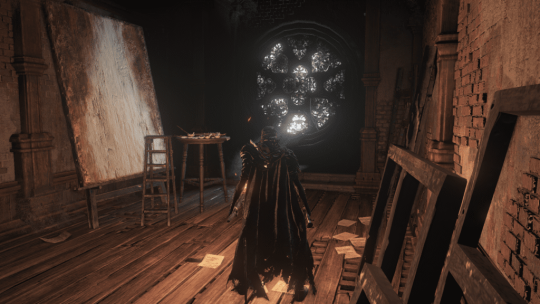
#dark souls#dark souls 3#lords of cinder#game entrainment#dark souls analysis#dark souls lore#ariandel#slave knight gael#the painted world
74 notes
·
View notes
Text

10 notes
·
View notes
Text
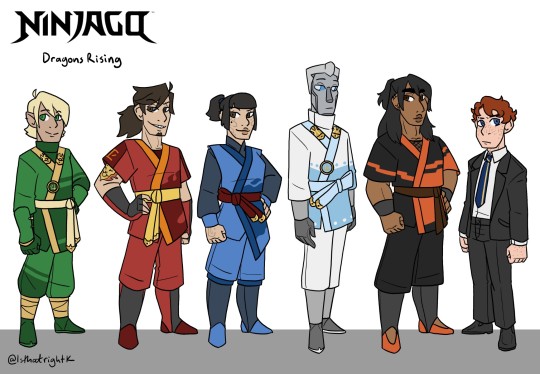
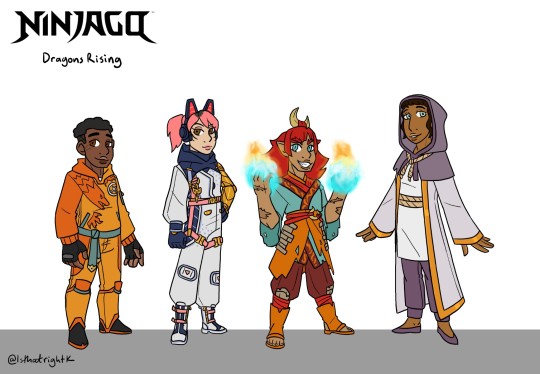
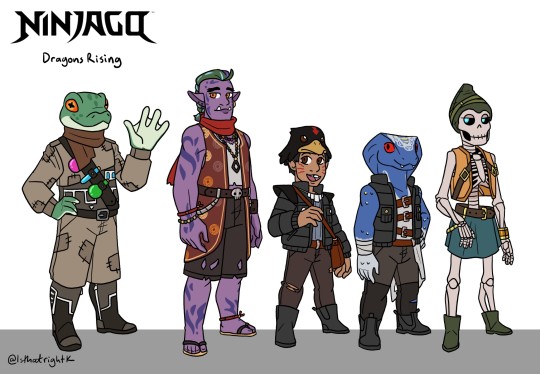
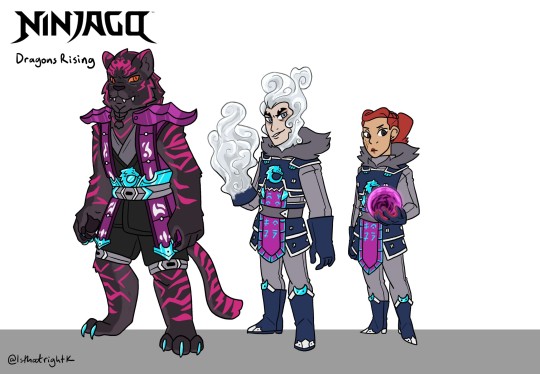
Boom! Some new Ninjago fanart are here. Really enjoyed s2 pt1 and can't wait for pt2
#ninjago#lego ninjago#lego ninjago fanart#ninjago dragons rising#ninjago lloyd#lloyd ninjago#ninjago kai#kai ninjago#ninjago nya#nya ninjago#ninjago cole#cole ninjago#ninjago zane#zane ninjago#jay ninjago#ninjago jay#ninjago arin#ninjago sora#ninjago wyldfyre#ninjago euphrasia#ninjago lord ras#ninjago cinder#ninjago jordana#ninjago frohicky#ninjago geo#ninjago fritz#ninjago spitz#ninjago bonzle
453 notes
·
View notes
Text
Soulsborne Final Bosses poorly explained
Dark Souls: God is senile, forcibly retire him.
Dark Souls 2: Lich King Cersei Lannister tricked you into doing her dirty work or Treebeard with the One Ring beats your ass.
Dark Souls 3: Parry all you want, you can’t parry the feels.
Sekiro: Swordsman hatches from grandson, shoots you in face.
Bloodborne: Local paraplegic regains use of legs specifically to kick your ass. Failing that, the moon does it for him.
Elden Ring: Kill God’s malesona and pet amoeba.
#incorrect super smash bros#Soulsborne#Shadowsoulsborne Ring#Dark Souls#Dark Souls 2#Dark Souls 3#Sekiro#Sekiro Shadows Die Twice#Bloodborne#Elden Ring#Gwyn#Gwyn Lord of Cinder#Nashandra#Aldia#Aldia Scholar of the First Sin#Gehrman#Gehrman the First Hunter#Radagon#Radagon of the Golden Order#Marika#Queen Marika the Eternal#Elden Beast#meme#funny#joke
3K notes
·
View notes
Text
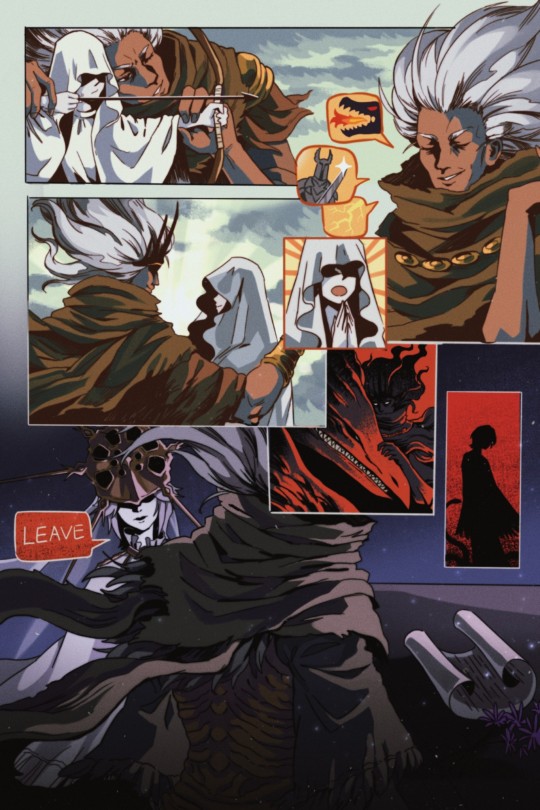
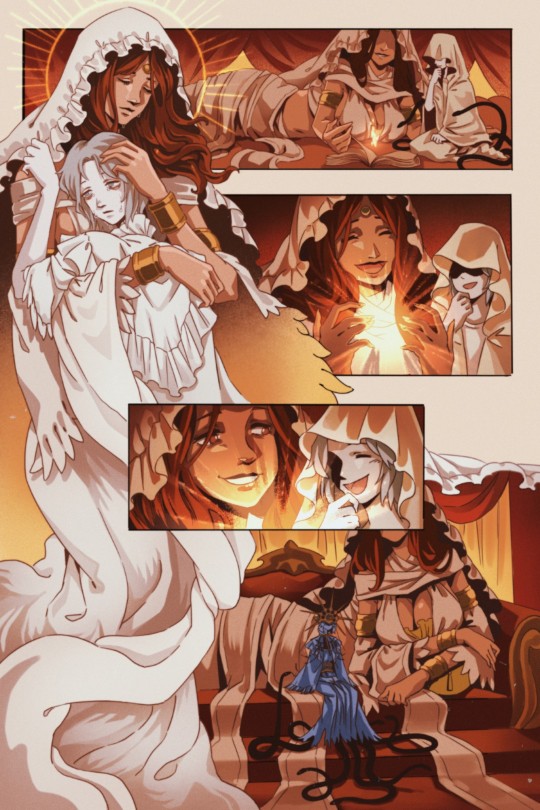

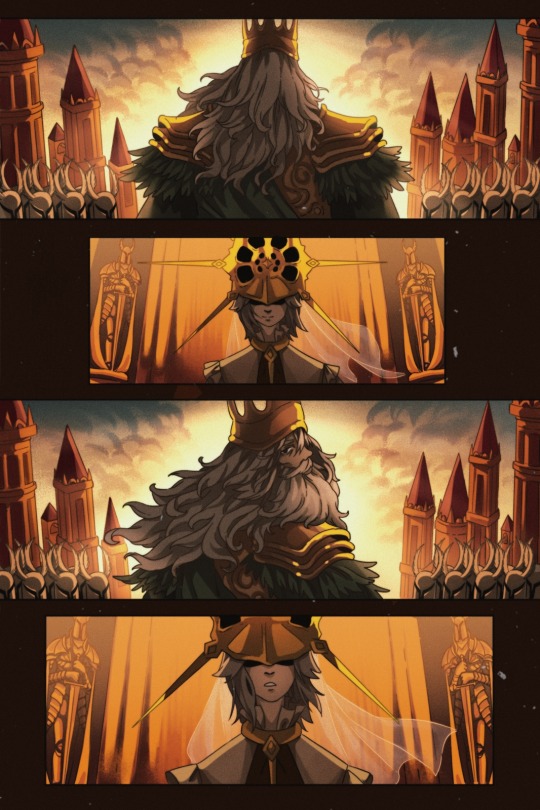
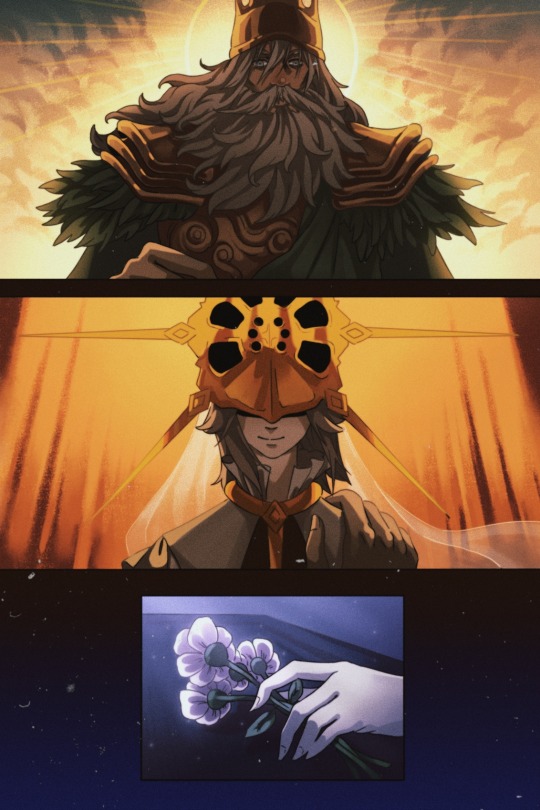
Family....
#dark souls#dark souls fanart#dark souls gwyndolin#dark sun gwyndolin#gwyndolin#dark souls gwyn#gwyn lord of cinder#dark souls gwynevere#gwynevere#gwyn#filianore#nameless king
1K notes
·
View notes
Text
How does bro fit in there💀

#Im in a esports competition rn w my team#If we win i'll draw cinder in a bunny onesie/...hj?#Ninjago#Lego ninjago#ninjago garmadon#Ninjago sensei garmadon#Sensei garmadon#Ninjago nya#Nya smith#Lord garmadon#Ninjago season 3#Ninjago fandom#ninjago rebooted#Esports#ninjago cinder
288 notes
·
View notes
Text
Ninjago Dragons Rising Memes (S1 and 2)
(Spoilers)







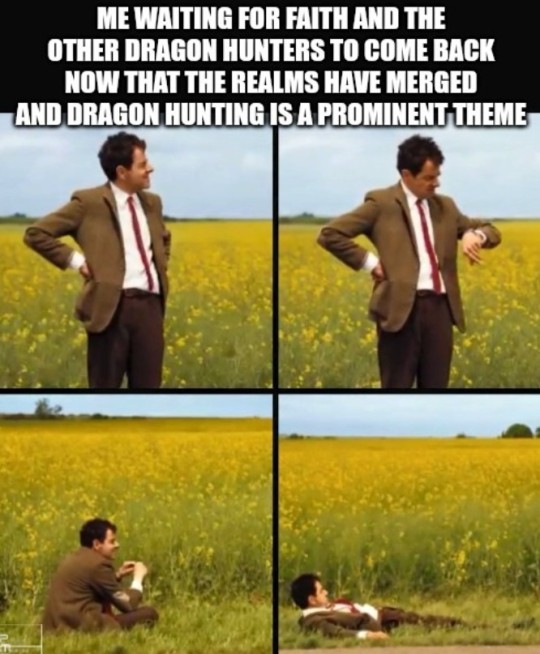
#ninjago#lego ninjago#ninjago dragons rising#ninjago dr#ninjago dr s2#ninjago dr spoilers#ninjago memes#ninjago dr memes#ninjago lloyd#ninjago cole#ninjago geo#lostshipping#ninjago cinder#ninjago jordana#ninjago ras#lord ras#lloyd garmadon#ninjago faith#dragon hunters
207 notes
·
View notes
Text
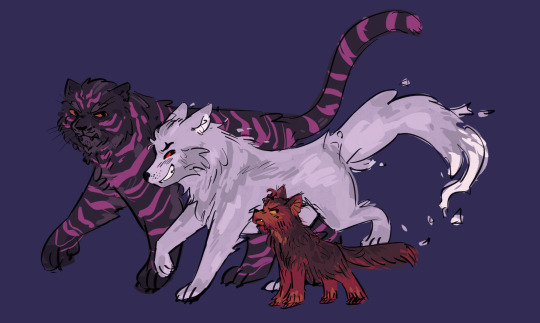
these guys are so dysfunctional its awesome
#ninjago#ajax art#dragons rising#ninjago spoilers#lord ras#cinder ninjago#ninjago jordana#wolf clan trio
302 notes
·
View notes
Text
New poster for dragons rising season 2, found on the ninjago wiki

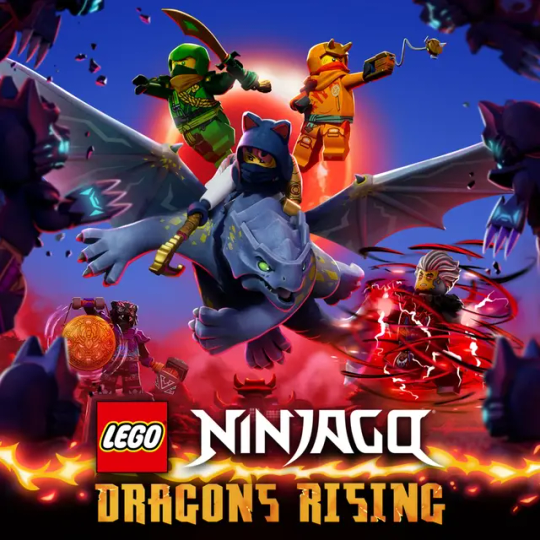
Sora has a hook to poke people with, the bestest boy Riyu is angry, Ras is a menace and Cinder is somewhere between badass and edgelord. Arin doesn‘t really have anything new and Lloyd looks awesome in that climbing suit. Also that is a lot of Wolf warriors
#ninjago#ninjago dragons rising#dragons rising season 2#sora#arin#lloyd#ras#lord ras#cinder#ninjago cinder#ninjago ras#ninjago lord ras#ninjago lloyd#Lloyd garmadon#lloyd montgomery garmadon#ninjago arin#ninjago sora
237 notes
·
View notes
Text

My fav band released new album, so it's time for song-inspired angsty drawings with certain fiery deities.
#my art#dark souls#gwyn lord of cinder#manus father of the abyss#furtive pygmy#song inspired#I love these destructive idiots so much
255 notes
·
View notes
Text

A quick little something for my darling Retro!
#FRFanArt#I'm doing chibis this week for LvA in the Illuminarti thread!! come on by hehehehehe#flight rising#flightrising#aether#flight rising aether#fr aether#aether fr#chibi#dragon#dragons#digital art#art tag#WOO I haven't posted here in a while#dear lord cinder and blaze are SO complicated#I FORGOR AETHERS HAVE MULTIPLE PAIRS OF LIMBS.................................................... but it is Too Late.#I already merged everything like A Fool
207 notes
·
View notes
Text
Been thinking about Jay doing shatterspin;
To me Nokt is supposed to look like Some of the guys we meet in the island arc and it makes me wonder if his element will be something relating to lightning.
When he finds out Jay can control lightning He will basically became a tutor for Jay and take him under his wing because I’m sure he can teach Jay more than just shatterspin
I wonder if Nokt is gonna teach him something about combining elements with shatterspin technique.
Essentially the more destructive an element is by nature the more powerful the “Elemental shatterspin”.
And wouldn’t you know it, Jay is the master of 1.32 megavolts.
When Jay finds out how much of an ass Ras is he will try to get Nokt out of Rass control.
he’d either put on a wolf mask and do shatterspin or Nokt would’ve already taught him it and we��ll get a parallel to the “Kai learns dragon rising technique” scene.
and he will body the absolute shit out of Ras while Cinder just watches in awe and Is like “yo how the fuck is he doing that”.
Jays shatterspin would essentially be a recreation of the demon core.
Oh and you can probably throw in a “Jay is in disguise fighting Cole and Nya who think he’s dead because some asshat Ras hired has his powers, so they will not hold back against him and neither will he”.
Just for good measure :)))))

#ninjago dragons rising#dragons rising season 2#lego ninjago#ninjago#dragons rising#jay walker#ninjago jay#evil jay#suit jay#ninjago ras#lord ras#ninjago nokt#forbidden five#ninjago shatterspin#cinder ninjago#ninjago cinder#Smugs thoughts and rambles#ninjago jaya#bruiseshipping#mmm yes put some angst on my ships#ninjago fandom
77 notes
·
View notes
Text
MEME HOUR: Dragons rising s2 pt. 3
💀 Spoiler alert 💀
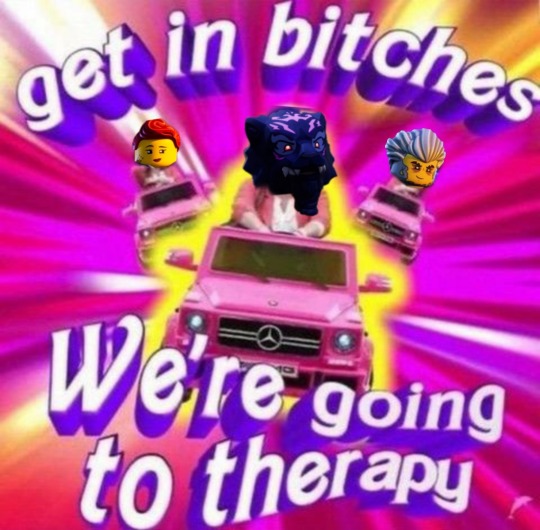




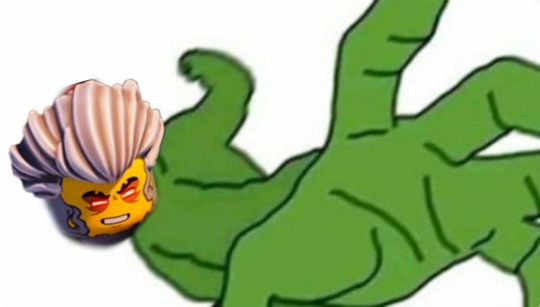
#ninjago#ninjago spoilers#ninjago dragons rising#ninjago memes#ninjago cinder#cinder lover's club#i believe in cinder supremacy 🙌🏻#cinder is so good at beating sh!t out of ninja#ninjago lloyd#lloyd garmadon#lord ras#jordana ninjago#ninjago cole#cole brookstone#ninjago geo#meme hour#lego memes#ninjago dr#ninjago dr memes#ninjago dragons rising spoiler#lego ninjago#getacronixedmeme
100 notes
·
View notes
Text
Dragons Rising Season 2, Episode 5: The Spell at the Waterfall
HALFWAY POINT!!!
I love the plush. I want the plush. I need the plush.
"I do not experience heightened emotions." You LIAR.
Zane, those lanterns are not blocking the portal gate.
The orb is Wu and Wu just saved them all.
Not Bonzle casually lore dropping.
Zane is SO ADORABLE with his little plush.
Again, I do not like the elemental mechs.
Egalt, keep your ugly mouth shut.
I can't believe the fang ranking was a truth.
Glad Wyldfyre knows her element now.
I feel so bad for Bonzle. Her story is so sad.
ZANE CUDDLING WITH THE PLUSH?? GEO AND COLE HOLDING HANDS???
WU????????????
Awee poor Riyu.
Motion... like the source dragon that gave Lloyd the vision of Egalt.
"Little fire man." I love.
I NEED TO READ SPINJITZU BROTHERS SOME PLEASE TELL ME HOW YOU FIND IT.
I wonder when in the timeline Wu met Bonzle.
Ohhhh Wyldfyre... she's so silly. Waaaait is this the disguise Doc was talking about that was "worse" than Doyll Donmagar?
Egalt, don't you DARE make Arin feel bad.
I want to give Arin the biggest hug ever.
I've been talking about a rift between Arin and Lloyd. This is the scene where I can see it starting. Arin shoves Lloyd off when Lloyd suggests to run drills with him.
MORE COLE AND GEO HAND HOLDING.
THE HUGS OHHGHHHHHHH
"You are loved and needed." HHHHGHH COLEEEE.
It is hilarious to me that Ras is having Cinder training with literal vases like literally those would break under any sort of pressure.
WHERE IS RAS GOING??
Soooo Lloyd and Ras get eerily similar visions.
Human sacrifices! Cool!
Soooo this season continues to break my heart. But also, it makes me so so so happyyyyy!!! I love Cole and the Finders with my whole heart. This episode literally confirms Lost as canon. Let's be honest.
Arin's self doubt is being heightened. Poor guy. Egalt is too harsh on him.
I don't even know how to compile my thoughts because there are like eight thousand things happening up here.
Until next episode!
#llannas dr recap#ninjago spoilers#ninjago#dragons rising#dragons rising spoilers#lloyd garmadon#ninjago lloyd#kai jiang#ninjago kai#nya jiang#ninjago nya#zane julien#ninjago zane#cole brookstone#ninjago cole#geo ninjago#sora ninjago#wyldfyre ninjago#arin ninjago#cinder ninjago#lord ras#jordana ninjago
70 notes
·
View notes
Text
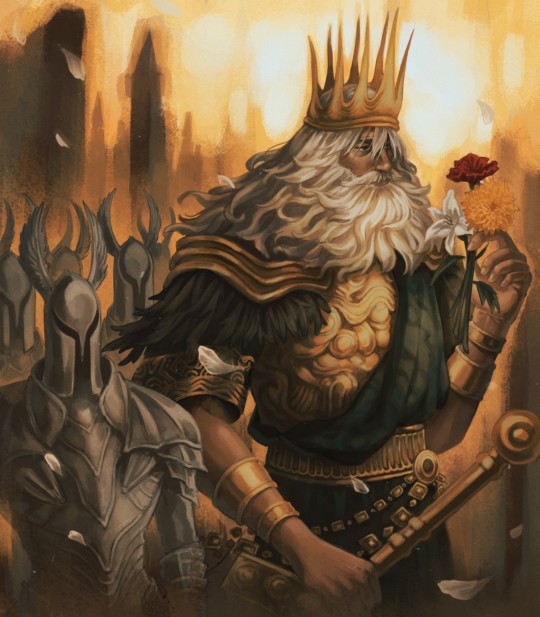

The first Lord of cinder
The first sinner......
415 notes
·
View notes
Text
i only got three frames left before i finish this pmv and im actually so proud of my cinder and lord ras drawings... my inner warrior cats fan finally showed itself again
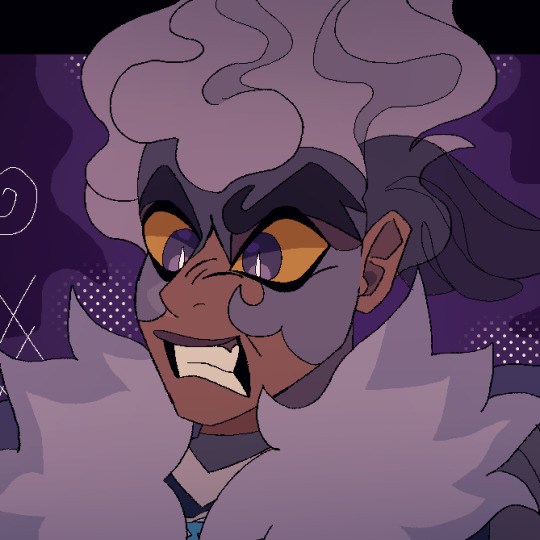

sneak peaks cause AUGHH I LOVE DRAWING THEMMM
101 notes
·
View notes